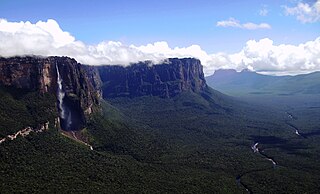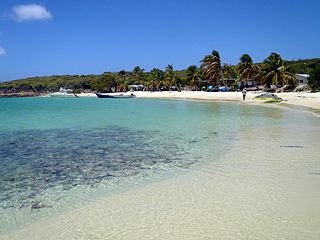
The Arctic Archipelago, also known as the Canadian Arctic Archipelago, is an archipelago lying to the north of the Canadian continental mainland, excluding Greenland and Iceland.

Canaima National Park is a 30,000 km2 (12,000 sq mi) park in south-eastern Venezuela that roughly occupies the same area as the Gran Sabana region. It is located in Bolívar State, reaching the borders with Brazil and Guyana. The park was named a World Heritage Site by UNESCO.
Sundance Air Venezuela S.A. is a cargo and private charter airline based in Porlamar, Venezuela. It is a start-up airline with services within Venezuela and to the Caribbean.
La Gran Sabana is a region in southeastern Venezuela, part of the Guianan savanna ecoregion.
The Trojan Range is a mountain range rising to 2,760 metres (9,055 ft), extending northward from Mount Francais along the east side of Iliad Glacier, Anvers Island, in the Palmer Archipelago of the British Antarctic Territory. It was surveyed by the Falkland Islands Dependencies Survey (FIDS) in 1955 and named by the UK Antarctic Place-Names Committee (UK-APC) for the Trojans, one of the opposing sides in the Trojan War in Homer's Iliad.

The Islas Los Frailes are an archipelago of rock islets with sparse scrub vegetation belonging to the Federal dependencies of Venezuela, part of Venezuela.

The Churún River is a river in Venezuela, part of the Orinoco River basin. It is located around 6.0666667°N 62.6°W, in Canaima National Park and a tributary comes from the Angel Falls, which are the world's tallest single-drop waterfall. It rises in Canaima National Park, and its mouth is the Carrao River.
The Los Hermanos Archipelago is a chain of seven rocky barren islets that is part of the Federal Dependencies of Venezuela, at 11°45′N64°25′W.

Arraya de Oca is a municipality and town located in the province of Burgos, Castile and León, Spain. According to the 2004 census (INE), the municipality has a population of 53 inhabitants.
Upuigma-tepui, also known as El Castillo, is a tepui in Bolívar state, Venezuela. A relatively isolated peak, both it and nearby Angasima-tepui lie just south of the vast Chimantá Massif, from which they are separated by the Río Aparurén valley. Upuigma-tepui is situated entirely within the bounds of Canaima National Park.

Los Testigos Islands are a group of islands in the southeastern Caribbean Sea. They are a part of the Dependencias Federales of Venezuela.
La Sola Island is a small island in the southeastern Caribbean Sea. The island is a part of the Dependencias Federales of Venezuela.
Gori is a village in the Manni Department of Gnagna Province in eastern Burkina Faso. The village has a population of 806 as of 2005.
The Findlay Group is a group of islands in the Arctic Archipelago in Qikiqtaaluk Region, Nunavut. This Arctic Ocean group consists of Lougheed Island, Stupart Island, Edmund Walker Island, Grosvenor Island and Patterson Island.

Stadium Nueva Esparta, also known as Estadio Guatamare, is a stadium in Porlamar, Venezuela. It is primarily used as a baseball park, hosting the Bravos de Margarita's home games. It holds 18,000 people and was opened in 1956.

Canaima Airport is an airport in Canaima, a town in Canaima National Park in the state of Bolívar in Venezuela. The airport and town are next to the Carrao Rapids on the Carrao River, and 46 kilometres (29 mi) downstream of Angel Falls.
The Chimantá Massif is a highly fragmented complex of tepuis in Bolívar state, Venezuela. The massif comprises around 11 tepuis and has a total summit area of 615 km2 (237 sq mi) and an estimated slope area of 915 km2 (353 sq mi). It is divided in two by the Río Tírica, with the northern section being both larger and higher. The massif is notable for its high species richness and for its varied habitat types. It reaches an elevation of 2,698 metres (8,852 ft) on its highest peak, Murey-tepui. The massif is situated entirely within the bounds of Canaima National Park. It hosts extensive cave systems, including the world's largest known quartzite cave, Cueva Charles Brewer, named after discoverer Charles Brewer-Carías. The processes behind their speleogenesis are the subject of some debate.
Canaima is a genus of cellar spiders that was first described by B. A. Huber in 2000.








